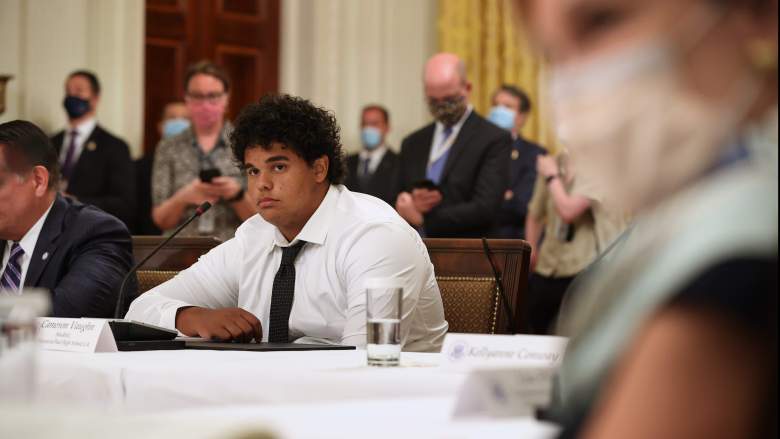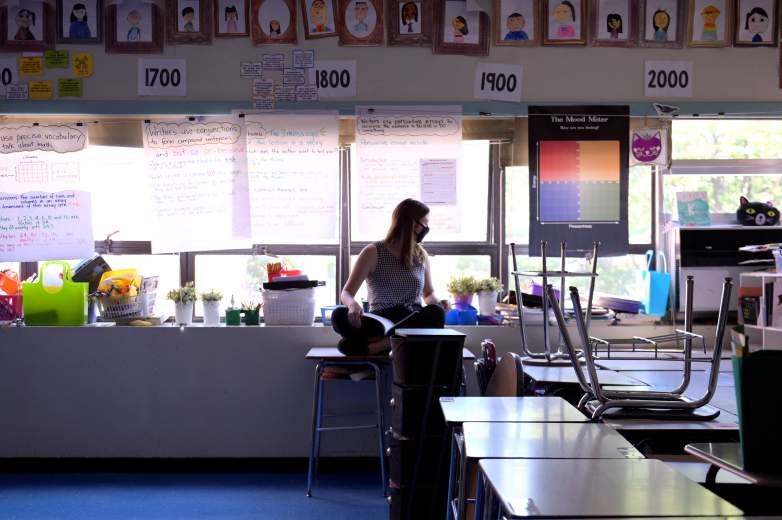
Getty St. Vincent de Paul High School student Cameron Vaughn participates in a meeting with U.S. President Donald Trump, fellow students, teachers and administrators about how to safely reopen schools during the novel coronavirus pandemic on July 7. As the number of COVID-19 cases surges across southern states like Florida, Texas, Louisiana, South Carolina and Arizona, Trump joined with guests from across the country to discuss how to responsibly return to the classroom.
With less than two months left for summer break, school districts, faculty, parents and students are all still wondering how to safely continue kids’ educations as cases of coronavirus continue to grow in most areas of the U.S.
Republican leaders are emphatic: Schools must reopen, they say. President Donald Trump tweeted July 8 that he may consider defunding schools if they don’t reopen.
He Tweeted, “In Germany, Denmark, Norway, Sweden and many other countries, SCHOOLS ARE OPEN WITH NO PROBLEMS. The Dems think it would be bad for them politically if U.S. schools open before the November Election, but is important for the children & families. May cut off funding if not open!”
The push for full reopening is also echoed by Education Secretary Betsy DeVos who told state governors on a conference call July 7, “Ultimately, it’s not a matter of if schools need to open, it’s a matter of how. Schools must reopen, they must be fully operational. And how that happens is best left to education and community leaders,” the Associated Press reported.
In Florida, Governor Ron DeSantis has already directed that all schools must open at normal capacity in August, even as the state is inundated with cases of COVID-19, and more than 80% of the state’s hospitals are out of ICU beds for adults, CBS reported.
Florida’s Education Commissioner, Richard Corcoran, is in agreement that schools should open fully, declaring an emergency order on July 6 mandating all schools must open five days a week for the 2020-2021 school year.
As part of the reopening plan, the Florida Department of Education concedes, “while educational programs should maintain maximum distance between students’ desks, this distance may often not reach six-feet,” yet they encourage all schools to do their best.
However, one exception is that if a county health department deems that schools should be closed in its county, those schools would get a pass.
Some Teachers & Faculty Say the Risk Is Still Too High to Open Schools, yet They’re Getting No Say

GettyA teacher collects personal belongings and supplies needed to continue remote teaching through the end of the school year at Yung Wing School P.S. 124 on June 9, 2020, in New York City.
Teachers and faculty are pushing back on Trump, DeVos and Desantis’ order that schools need to reopen fully. The risk is great not only for teachers, they say, but for their families and students’ families who may have health issues. The general feeling seems to be that none of that is taken into account.
An elementary school teacher in Pinellas County, Florida, who didn’t want to be named, told Heavy she has many concerns about returning to school.
“No teacher signed up to be put in an unsafe situation with no PPE provided but maybe a mask. Who will do the sanitizing each day? Who will pay for it? There is not enough money to follow the CDC guidelines,” she said.
According to the teacher, who has been working in elementary schools for five years, much is not being considered in the reopening approach. She questioned how it’s possible to keep 6 feet of separation between kids in small classrooms. Air conditioning in Florida schools is often on the fritz and air-circulation could be a problem, she said. She added that small kids really can’t wear a mask all day and questioned how often schools would have to deal with disruptions when someone tests positive and they have to close to sanitize.
“When we get sick, who will want to sub?” she said. “When a teacher gets sick and dies, is it considered negligence? There will be a need for more guidance counselors to deal with grief when staff and students start to die.”
She also thinks a big part of the push to send kids back is so that parents can go back to work more easily.
“Parents send their kids to school sick every day during flu season, covering up fevers with Tylenol before school,” the Florida teacher says. “We understand that people need to work, but school is not meant to be free childcare.”
According to the teacher, who is a member of The Florida Education Association — the teacher’s union — she doesn’t know one teacher who is comfortable returning to school next month.
“None of it makes much sense,” she said. “Most of us feel like nothing will be normal or nurturing, so why not keep it digital for a while longer? Virtual instruction is not any teacher’s ideal method of instruction but we need to make it work until we see 14 days with a real decline in cases before even considering the ‘brick and mortar’ version of school. Then we can phase slowly back to normal.”
A critical joint statement from six education groups, including the National Education Association, National Parent Teacher Association and American Federation of Teachers, was drafted in response to Trumps’s push to open schools. The letter says the Trump administration has “zero credibility in the minds of educators and parents when it comes to this decision.”
The letter says, in part:
Throughout this pandemic, the administration has failed to address the needs of students, especially those students who need the most support. They have failed to listen to families and public school educators who have been on the frontlines serving their communities. This vacuum of leadership leaves this administration with zero credibility in the minds of educators and parents when it comes to this major decision. To safely re-open our schools, health experts should be relied on to figure out the “when” and educators and parents should be central to figuring out the “how.” Public school educators, students and parents must have a voice in critical conversations and decisions on reopening schools. The president should not be brazenly making these decisions.
Trump Says He Disagrees With the CDC’s Guidelines on Safely Reopening Schools & the American Academy of Pediatrics Thinks There Should Be a Goal of Having Kids in School In-Person
In a follow-up tweet, the president said he’d be talking with the CDC about their guidelines because he disagrees with them, calling them “very tough, expensive” and “impractical.”
The CDC’s guidelines layout options for various scenarios, including shutting down for two to five days if someone at the school becomes infected so that stringent cleaning measures can be taken. The guidelines also suggest that schools stagger arrival and dismissal times to minimize contact during these busy times of day.
Other directives are vague, like “implement social distancing strategies” in the classroom and while walking through the halls, and “consider ways to accommodate” high-risk students and faculty.
Yet those are the guidelines that have been in place all along. With the pushback from schools, Trump may be looking more closely at the CDC’s guidelines. As with many decisions during the pandemic, it’s another case of best practices to slow the spread of a potentially deadly virus versus the need for normalcy and economic stability — but in this case, childhood development must also be taken into consideration.
The American Academy of Pediatrics weighs in on behalf of children, saying “the AAP strongly advocates that all policy considerations for the coming school year should start with a goal of having students physically present in school,” and yet, “Policies to mitigate the spread of COVID-19 within schools must be balanced with the known harms to children, adolescents, families, and the community by keeping children at home.”
According to the AAP, whose job it is to look at what is ideal for childhood development:
There is already evidence of the negative impacts on children because of school closures in the spring of 2020. Lengthy time away from school and associated interruption of supportive services often results in social isolation, making it difficult for schools to identify and address important learning deficits as well as child and adolescent physical or sexual abuse, substance use, depression, and suicidal ideation. This, in turn, places children and adolescents at considerable risk of morbidity and, in some cases, mortality.
All that considered, experts say it is not the students who are most at risk from COVID-19, and school districts are left with the impossible choice of looking out for best the interests of students and faculty.
According to the Florida elementary school teacher, there is one solution.
“Teachers and families should be given the choice to return in person,” she said.
READ NEXT: Reported COVID-19 Deaths Are Down But Early Testing May Not Tell Whole Story